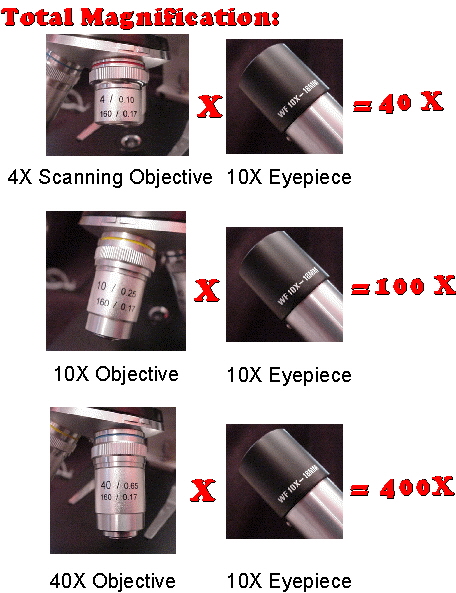2.1 OCULAR MICROMETER
INTRODUCTION
An ocular micrometer is a glass disk that fits in a microscope eyepiece that has a ruled scale, which is used to measure the size of magnified objects. The physical length of the marks on the scale depends on the degree of magnification.
OBJECTIVE
To measure and count cells using a microscope
MATERIALS AND REAGENT
Microscope fitted with an ocular micrometer
Slide micrometer
Stained preparation of yeast and bacteria
PROCEDURE
(refer to lab manual)
RESULT
Total magnification = objective lens power x eyepiece lens power(10x)
The ratio of magnification was calculated by:
the observed diameter of yeast is 1mm ocular
Using 40x magnification,
1mm on stage represent 8.9mm on eyepiece under 40x magnification view
Magnification
|
Ocular(mm)
|
Stage(mm)
|
10x
|
0.89
|
0.1
|
40x
|
8.9
|
1.0
|
CONCLUSION
The size of the microorganism can be measured by using ocular micrometer and stage micrometer.
REFERENCES
http://en.wikipedia.org/wiki/Ocular_micrometer
http://www.mecanusa.com/microscope/micrometer/micrometer-use_en.html
2.2 NEUBAUER CHAMBER
INTRODUCTION
The hemocytometer is a device used to count cells. It was originally designed for the counting of blood cells.
The hemocytometer was invented by Louis-Charles Malassez and consists of a thick glass microscope slide with a rectangular indentation that creates a chamber. This chamber is engraved with a laser-etched grid of perpendicular lines. The device is carefully crafted so that the area bounded by the lines is known, and the depth of the chamber is also known. It is therefore possible to count the number of cellsor particles in a specific volume of fluid, and thereby calculate the concentration of cells in the fluid overall.
MATERIALS AND REAGENTS
Serial dilutions of bacteria cultures
Neubauer and coverslip
70% ethanol
Sterile Pastuer pipettes
PROCEDURE
(refer to lab manual)
Serial dilutions of bacteria cultures
Neubauer and coverslip
70% ethanol
Sterile Pastuer pipettes
PROCEDURE
(refer to lab manual)
RESULT
Number of
cell = 1550
Boxes = 5
1550 = 310 (average for 1 box)
5
Total 256 small box = 310 x 256
= 79360
Volume = 1 x 1 x 0.1
= 0.1mm3
1mm3 = 0.001cm3
0.1 mm3 = 1 x 10-4mL
1 x 10-4 cm3 = 1 x 10-4mL
79360
|
1 x 10-4mL
|
Concentration =
= 793 600 000
CONCLUSION
By using the neubauer chamber, we can estimate and hence calculate the number of microorganisms
REFERENCES
http://www.microbehunter.com/the-hemocytometer-counting-chamber/
http://groups.molbiosci.northwestern.edu/morimoto/research/Protocols/II.%20Eukaryotes/A.%20Cell%20Culture/3b.%20Hemacytometer.pdf










